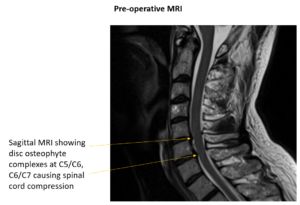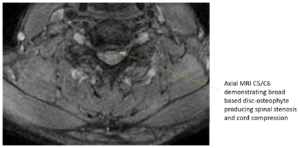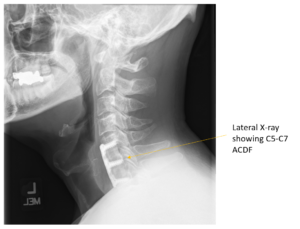How ACDF Surgery Erased the Pain Following a Ski Accident
Dr. Eubanks helps patient get back on the slopes
SYMPTOMS & HISTORY
Burning pain in both arms with numbness and tingling sent Scott, a 61-year-old businessman, to see Dr. Eubanks for help. He had recently had a skiing accident in Colorado when he collided with another skier and hit his head. Fortunately, there was no neurological damage, lasting weakness or other deficits. Based on his symptoms and MRI images, Scott was diagnosed with an underlying cervical stenosis and had sustained trauma to the spinal cord known as a central cord syndrome. Initially, it seemed Scott’s symptoms were improving. Dr. Eubanks first prescribed non-operative care, with recommendations to modify his activities and keep a close watch on what movements may generate pain or numbness. Over the next six months, however, Scott’s symptoms persisted. In follow up visits, he reported that when his neck was in extension during prolonged bike riding, his arms hurt more. He also noticed numbness in his hands while playing the guitar. Overall, his quality of life was greatly diminished. Despite the accident, the thought of not skiing in the upcoming season was not acceptable. After consulting with Dr. Eubanks, Scott decided to proceed with an ACDF surgery to relieve the spinal cord/nerve root compression.
DIAGNOSIS
Cervical Stenosis & Central Cord Syndrome (Spinal Cord Trauma)
Spinal stenosis is one of the most common spinal conditions leading to surgery in older patients. Stenosis is a medical term meaning narrowing and can happen in any region of the spine. The bones of the spine, or vertebrae, sit on top of each other with a disc between them. The spinal cord runs through the vertebrae through a channel called the spinal canal. Spinal stenosis is a pinching of the spinal cord or nerve roots due to narrowing of the canal. Another form of stenosis, foraminal stenosis, refers to narrowing of the holes through which the individual nerves exit the spinal canal. Stenosis can be caused from a combination of spine problems from chronic degenerative arthritis to acute disc herniations. In Scott’s case the degeneration of aging was compounded by the trauma of hitting his head in the skiing accident, compressing the cord even further.


TREATMENT
Dr. Eubanks determined that a minimally invasive technique called anterior cervical discectomy fusion (ACDF) could ease Scott’s pain and uncomfortable symptoms. ACDF is a surgical procedure that involves relieving the pressure placed on nerve roots and/or the spinal cord.
Anterior Cervical Discectomy Fusion (ACDF)
 Cervical refers to the seven vertebrae of the neck. Discs are the spongy, cartilaginous pads between each vertebra and “ectomy” means “to take out.” In a cervical discectomy, the surgeon accesses the cervical spine through a small incision in the neck and removes all or part of the disc – and/or in some cases bone material – that’s pressing on the nerves and causing pain.
Cervical refers to the seven vertebrae of the neck. Discs are the spongy, cartilaginous pads between each vertebra and “ectomy” means “to take out.” In a cervical discectomy, the surgeon accesses the cervical spine through a small incision in the neck and removes all or part of the disc – and/or in some cases bone material – that’s pressing on the nerves and causing pain.
Spinal fusion involves placing bone graft between two or more affected vertebrae to promote bone growth between the vertebral bodies. The graft material acts as a binding medium and helps maintain normal disc height. As the body heals, the vertebral bone and bone graft eventually grow together to join the vertebrae and stabilize the spine.
RESULTS
Following the surgery, Scott’s upper extremity symptoms completely resolved and at the three-month follow-up he was asymptomatic and ready to return to activities he enjoys.
WE CAN HELP
If you’re experiencing similar pain or symptoms that you feel may be related to a spine problem, we can help.
Schedule a consultation with Dr. Eubanks at (216) 844-7200.
